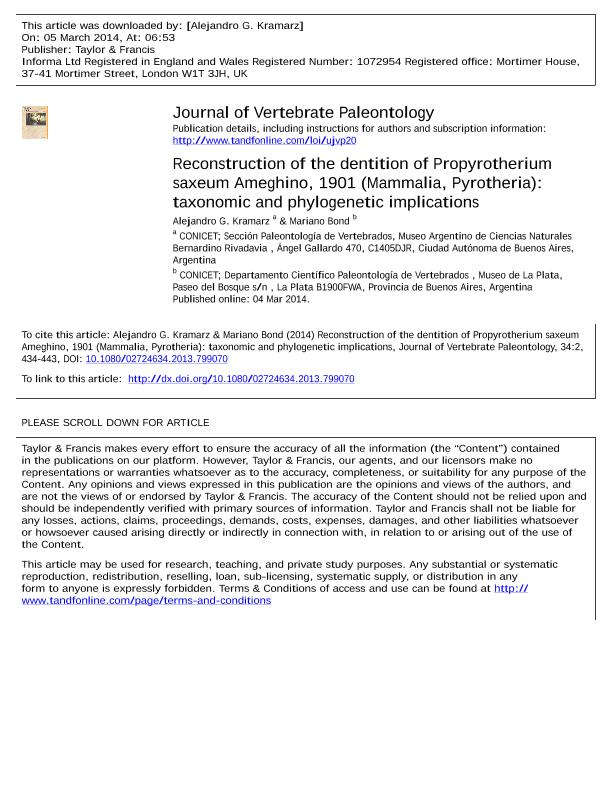Mostrar el registro sencillo del ítem
dc.contributor.author
Kramarz, Alejandro Gustavo

dc.contributor.author
Bond, Mariano

dc.date.available
2017-12-05T16:07:50Z
dc.date.issued
2014-03
dc.identifier.citation
Kramarz, Alejandro Gustavo; Bond, Mariano; Reconstruction of the dentition of Propyrotherium saxeum Ameghino,1901 (Mammalia, Pyrotheria): Taxonomic and phylogenetic implications; Society of Vertebrate Paleontology; Journal of Vertebrate Paleontology; 34; 2; 3-2014; 434-443
dc.identifier.issn
0272-4634
dc.identifier.uri
http://hdl.handle.net/11336/29724
dc.description.abstract
Propyrotherium saxeum is one the least known members of Pyrotheria, an enigmatic group of extinct, giant, endemic South American ‘ungulates.’ The species was originally described based upon two isolated cheek teeth and two tusk fragments. Later authors assigned additional isolated teeth to this taxon, but the position within the tooth row of all these teeth remained uncertain, preventing an accurate dental characterization and taxonomic distinction from other related species. Here we reexamine the type specimens of P. saxeum and additional materials previously reported as belonging to this species, and analyze several lots of still undescribed specimens, in order to reconstruct the cheek tooth series. Based on comparisons with better known pyrotheres, we conclude that the most probable cheek teeth formula is P2–M3/p2–m3. The cheek teeth gradually increase in size from front to back, and the upper cheek teeth have a gradual increase in loph curvature, as in Pyrotherium. All cheek teeth are bilophodont, but in premolars the anterior loph/id is transversely shorter than the posterior. All have lingual/labial cingulum/id; P3–M3 are subquadratic and three-rooted; p4–m3 are longer than wide, two-rooted, and bear a variably developed vestige of cristid obliqua. Propyrotherium is distinguishable from Griphodon and Baguatherium, but the distinction between these latter two taxa is uncertain with the current evidence. A revised cladistic analysis confirms that Propyrotherium is one of the earliest diverging pyrotheriids, but the resolution of its relationship with Griphodon and Baguatherium requires further evidence.
dc.format
application/pdf
dc.language.iso
eng
dc.publisher
Society of Vertebrate Paleontology

dc.rights
info:eu-repo/semantics/openAccess
dc.rights.uri
https://creativecommons.org/licenses/by-nc-sa/2.5/ar/
dc.subject
Propyrotherium
dc.subject
Pyrotheria
dc.subject
Taxonomy
dc.subject
Phylogeny
dc.subject.classification
Meteorología y Ciencias Atmosféricas

dc.subject.classification
Ciencias de la Tierra y relacionadas con el Medio Ambiente

dc.subject.classification
CIENCIAS NATURALES Y EXACTAS

dc.title
Reconstruction of the dentition of Propyrotherium saxeum Ameghino,1901 (Mammalia, Pyrotheria): Taxonomic and phylogenetic implications
dc.type
info:eu-repo/semantics/article
dc.type
info:ar-repo/semantics/artículo
dc.type
info:eu-repo/semantics/publishedVersion
dc.date.updated
2017-12-05T15:19:31Z
dc.journal.volume
34
dc.journal.number
2
dc.journal.pagination
434-443
dc.journal.pais
Reino Unido

dc.journal.ciudad
Londres
dc.description.fil
Fil: Kramarz, Alejandro Gustavo. Consejo Nacional de Investigaciones Científicas y Técnicas. Oficina de Coordinación Administrativa Parque Centenario. Museo Argentino de Ciencias Naturales "Bernardino Rivadavia"; Argentina
dc.description.fil
Fil: Bond, Mariano. Universidad Nacional de La Plata. Facultad de Ciencias Naturales y Museo. Departamento Científico de Paleontología de Vertebrados; Argentina. Consejo Nacional de Investigaciones Científicas y Técnicas; Argentina
dc.journal.title
Journal of Vertebrate Paleontology

dc.relation.alternativeid
info:eu-repo/semantics/altIdentifier/doi/http://dx.doi.org/10.1080/02724634.2013.799070
dc.relation.alternativeid
info:eu-repo/semantics/altIdentifier/url/http://www.tandfonline.com/doi/abs/10.1080/02724634.2013.799070
Archivos asociados
